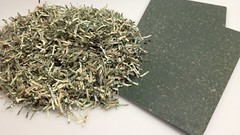
PREV ARTICLE
NEXT ARTICLE
FULL ISSUE
PREV FULL ISSUE
WHERE MONEY GOES TO DIE
John and Nancy Wilson forwarded this article on uses for old macerated currency. Thanks!
-Editor
Ford is no exception - only it's more interested in the shredded-up variety than in the kind that belongs to a fancy country club. Stepping up its efforts to curb the use of petroleum-based products, the automaker announced last month that it's attempting to use old U.S. cash to make trays and bins for its vehicles. Ford (F: 10.56, +0.22, +2.13%) already employs a range of alternative materials in the manufacturing of its products, including plastic bottles to make seat fabric and denim to muffle sound. The company is looking at ways to incorporate dandelions, coconuts and sugarcane into future vehicle parts as well. But U.S. paper currency is arguably the most interesting ingredient in Ford's recipe book. After all, it's hard to imagine that there's a supply of old bills that exists outside of a collector's safe or government vault - and if there is, that it isn't serving some lofty purpose. The reality is that old cash abounds, and with almost nowhere to go but the landfill. Because it's 75% cotton and 25% linen, currency paper is more durable than everyday paper, which is made mostly of wood pulp. It can withstand a lot of wear and tear - the U.S. Bureau of Engraving and Printing estimates that it takes about 4,000 double folds (meaning one fold forward and one fold back) to rip a bill. Still, bills do eventually wear out. Bills of smaller denominations tend to age the fastest, as they're passed around more frequently than those of larger denominations. The Federal Reserve estimates that the average $1 bill lasts 4.8 years, while $5 and $10 bills last 3.8 years and 3.6 years, respectively. On the higher end of the spectrum, the average $20 bill lasts 6.7 years, while $50 bills and $100 bills last 9.6 years and 17.9 years, respectively. The majority of bills that are too worn for circulation are shredded by the Federal Reserve Banks and sent to landfills. The Fed generated a total of about 5,300 tons of shredded paper currency in 2011, according to a spokesperson.
To read the complete article, see:
Where Money Goes to Die
(www.foxbusiness.com/personal-finance/2012/05/03/where-money The Numismatic Bibliomania Society is a non-profit organization promoting numismatic literature. See our web site at coinbooks.org. To submit items for publication in The E-Sylum, write to the Editor at this address: whomren@gmail.com To subscribe go to: https://my.binhost.com/lists/listinfo/esylum All Rights Reserved. NBS Home Page Contact the NBS webmaster 
|
